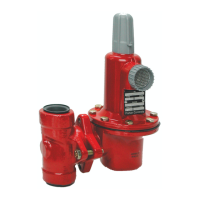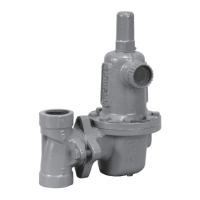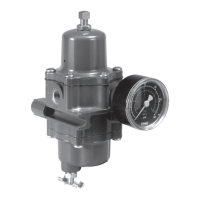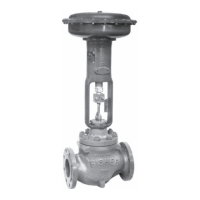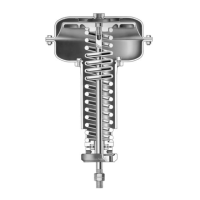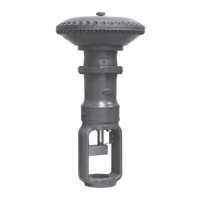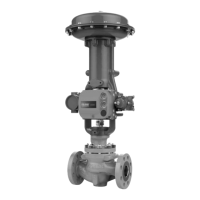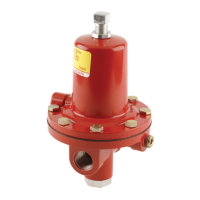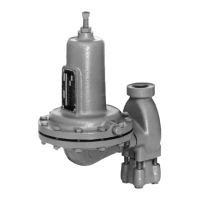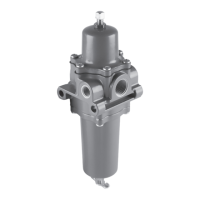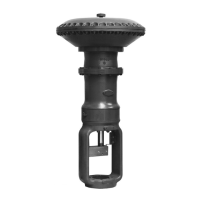627 Series
13
19. Secure the diaphragm casing (key 5) to the body
with the cap screws (key 3, Figure 5). For an
aluminum diaphragm casing, torque the cap screws
(key 3) to 16 foot-pounds / 22 N•m. For ductile iron
or steel diaphragm casings, torque the cap screws
(key 3) to 25 foot-pounds / 34 N•m.
20. It may be necessary to reposition the diaphragm
spring case to prevent rain, ice, and foreign
debris from entering the spring case. Refer to the
Diaphragm and Spring Case Area Maintenance
Procedures, steps 1, 2, and 21 through 25.
Diaphragm and Spring Case Area
Maintenance Procedures
These procedures are for gaining access to the control
spring, diaphragm assembly, and lever assembly. All
spring pressure must be released from the diaphragm
casing before these steps can be performed.
While using the following procedures, refer to
Figures 7 through 13 for key number locations.
1. Remove the adjusting screw cap (key 36), loosen
the lock nut (key 34), and turn the adjusting screw
(key 35) counterclockwise until all compression is
removed from the control spring (key 32).
2. Remove the spring case cap screws (key 37), the
nameplates, and lift off the spring case (key 29). If
changing the control spring (key 32) or repositioning
the spring case (key 29) is the only maintenance
required, install the replacement control spring
or rotate the spring case so it is correct for the
application. Skip to step 21. For diaphragm area
maintenance, continue with step 3.
3. Remove the diaphragm limiter O-ring and
diaphragm limiter (keys 51 and 50, on the
Type 627H or 627HM only). Remove the
diaphragm assembly by tilting it so that the pusher
post (key 19) slips off the lever (key 15).
4. If it is necessary to replace the lever assembly,
remove the lever cap screws (key 18).
5. Install the replacement lever (key 15) into the lever
retainer (key 16) by inserting the lever pin (key 17).
Secure the lever assembly into the diaphragm casing
with the cap screws (key 18) and torque the cap
screws to 7 foot-pounds / 9.5 N•m.
If it is necessary to perform maintenance on
the diaphragm assembly, continue with steps 6
through 11 and step 20 for Types 627, 627H,
627M, and 627HM regulators, or steps 12 through
19 for Types 627R, 627LR, and 627MR regulators.
Perform steps 6 through 11 for Types 627, 627H,
627M, and 627HM Regulators only:
6. For Types 627, 627H, 627M, and 627HM
regulators (Figures 5 and 6), use steps 7
through 11 to disassemble and reassemble the
diaphragm assembly.
7. Remove the diaphragm head cap screw (key 46),
lower spring seat (key 31, Type 627 or 627M only),
and diaphragm head (key 24). On the Type 627H
or 627HM, remove the pusher post O-rings
(key 52). Separate the diaphragm (key 23) from
the pusher post (key 19).
8. Install the diaphragm (key 23), in reverse order
in step 7, on the pusher post (key 19), insert and
nger tighten the diaphragm head cap screw
(key 46).
9. Hook the pusher post on the lever (key 15), then
turn the diaphragm (key 23) to match the holes in
the diaphragm with the holes in the spring casing.
10. Unhook the pusher post from the lever (key 15)
and torque the diaphragm head cap screw
(key 46) to 7 foot-pounds / 9.5 N•m for the
Type 627 or 627M. On the Type 627H or 627HM,
torque the diaphragm head cap screw to
14 foot-pounds / 19 N•m.
11. Hook the pusher post on the lever (key 15) and
check the hole alignment. If necessary, loosen the
cap screw (key 46) and reposition the diaphragm
(key 23) on the pusher post (key 19). Retorque
the screw (see step 10). Skip to step 20.
Perform steps 12 through 19 for Types 627R,
627LR, and 627MR Regulators only:
12. For Types 627R, 627LR, and 627MR
regulators (Figure 6), use steps 13 through
19 to disassemble and reassemble the
diaphragm assembly.
13. Remove the guide retainer (key 26) and separate
the diaphragm parts. Refer to Figure 6 for the
sequence of parts.
14. To remove the diaphragm (key 23), remove the
diaphragm connector nut (key 22) and lift off the
diaphragm head (key 24) and diaphragm (key 23)
from the connector assembly (key 21). Do not
attempt to disassemble the connector assembly
(key 21).

